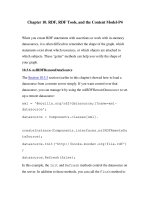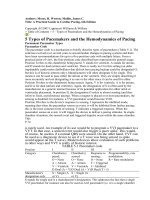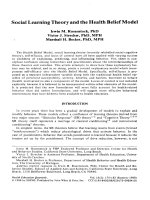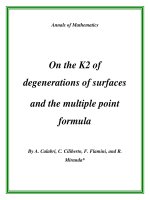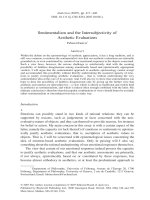Poetry and the Romantic Musical Aesthetic pptx
Bạn đang xem bản rút gọn của tài liệu. Xem và tải ngay bản đầy đủ của tài liệu tại đây (1.7 MB, 11 trang )
Poetry and the Romantic Musical Aesthetic
reviewed by Martine Prange
Hyperion, Volume V, issue 1, May 2010
135 Hyperion—Poetry and the Romantic Musical Aesthetic
reviewed by Martine Prange
University of Amsterdam & University of Maastricht (The Netherlands)
Poetry
and the
Romantic Musical Aesthetic
James H. Donelan
Cambridge University Press, 2008
a review of
T
wo hundred years have passed since the premiere of Beethoven’s Fifth
and Sixth Symphonies, the publication of Hegel’s Phenomenology of Spirit,
the end of Wordsworth’s Golden Decade, and the beginning of Hölderlin’s
madness, yet these four key fi gures of Romanticism and Idealism—all born
in the year 1770—still occupy a tremendous place in the collective cultural
imagination, for the reason that, as James Donelan argues in his fi ne Poetry
and the Romantic Musical Aesthetic, in their works they addressed issues of
‘identity, freedom, and beauty that still matter’ (p. 176), i.e., they express ‘hope
for the reintegration of the self through beauty’ (p. 177). That is the wider,
extra-musical meaning that absolute (instrumental/non-programmatic) music
conveys, particularly Beethoven’s String Quartet No. 13, according to Donelan.
‘How can music represent self-consciousness?’ is the central question of an
account that soon admits that music indeed can represent self-consciousness,
according to the Romantic-Idealist aesthetic, which goes so far as to imagine
music and self-consciousness as ‘mutually positing, reciprocal dialectical
structures’ (p. xi). Recently, Andrew Bowie already demonstrated the intimate,
mutually qualifying relationship between music and modern subjectivity
in Modern German philosophy, while inquiring the meaning of music ‘qua
music’ (instead of as ‘language’) in Aesthetics and Subjectivity from Kant to
Nietzsche (2
nd
ed. 2003) and Music, Philosophy, and Modernity (Cambridge
University Press, 2007). Donelan operates along similar lines, covering the
fi elds of literary criticism, musicology, and philosophy, and likewise starting
from the Oldest System Programme. Remarkably, though, Donelan denies
that other landmark framework of nineteenth-century musical discussions:
the binary opposition between beauty (produced by visual arts and poetry)
and the sublime (music), for undeclared reasons, as well as the question of
music’s unique power to create universal understanding and community, due
to its independence of language. His contextualization does not go so far as
to raise questions about music’s changing political and cultural function at the
time, although these questions indeed relate directly to the central question
of the expression (or representation) of self-awareness in music (as well as
to the question of the genius composer and the experience of the sublime)
as it rises with Romanticism and German Idealism. Donelan confi nes his
research methodologically to this single question, historically to the years
1795-1831, thus focusing on the new ontology of music that emerged in the
wake of Mozart’s struggle to overcome the patronage system of his time and
the celebratory character of music that went with it (i.e., celebrating God or
the patron), and geographically/culturally to the German-speaking (Hölderlin,
Hegel, Beethoven) and English-speaking (Wordsworth) worlds.
Concentrating on Hegel, Hölderlin, Wordsworth, and Beethoven, Donelan
moreover avoids the larger part of both German/English and wider Romantic
music. Of course, all Romantic music relates in one way or another to
Beethoven, but not accounting for skipping Wagner, Schopenhauer, Nietzsche,
Hyperion—Volume V, issue 1, May 2010 136
Verdi, and Strauss, while speaking of ‘the Romantic musical aesthetic’ in the
book title, is a substantial omission, next to its being a smart move if one wants
to shun discussion of one’s own essentialist characterization of Romanticism.
Would it not have been more obvious to discuss E.T.A. Hoffmann, Brendel,
Liszt, Wagner, Schopenhauer, Nietzsche, and the ‘war’ between Old and New
German School of Music over Beethoven’s symphonic legacy, if one claims
to discuss ‘the’ Romantic musical aesthetic rather than Hegel, Hölderlin, and
Wordsworth, the fi rst being a philosopher and the other two being poets?
Rather than pointing out the variety and development in different Romantic
musical aesthetic theories, however, Donelan sets out to explore how and
why the conception of the human self as an autonomous, free mind became
an object of artistic, more specifi cally musical refl ection in early Romantic
poetry and music. In other words, why was music, rather than poetry and
visual arts, so apt to express or represent selfhood? That Donelan chooses
Hegel, Hölderlin, Wordsworth, and Beethoven in this investigation is not
only because they were all born in 1770, but also for the reason that they, or
rather the works they produced discussed by Donelan, may be conceived as
exemplary for a whole range of scholars and artists that regarded music as of
utmost relevance for philosophy and aesthetics—their artworks expressing a
growing sense of self-awareness. Donelan analyses representative art works
as products and representations of the particular feelings and thoughts of the
individual artist. In this regard, however, it is rather estranging that so little
attention is paid to the Romantic cult of ‘genius.’
‘Self-consciousness,’ of course, is an invention of Enlightenment philosophy
and culture, subsequently explored by Romantic art and thought. Donelan
is aware of this, given his accuracy to outline, in a very clear, rather brief yet
narrative way (i.e., drawing upon secondary literature rather than arguing
his position in discussion with it) the developments intimating the Romantic
interest in ‘self-consciousness’ in chapter 1 (‘Self-Consciousness and
Music in the Late Enlightenment’). He points out its roots in Kant’s critical
works and Mozart’s transformation of Enlightenment musical aesthetics,
discusses further the Oldest System Programme fragment, after which he
devotes consecutive chapters to Hölderlin’s implementation of musical forms
in the Deutscher Gesang poems, the place of music in Hegel’s Lectures
on Aesthetics, Wordsworth’s poetical interest in sounds of nature, and the
expression of selfhood in Beethoven’s String Quartets. He does so in an
very readable, lucid, and elegant prose, however not always questioning
or explicating the different philosophical and aesthetic concepts (‘Idealism,’
‘subjectivity,’ ‘beauty’) and sometimes drawing more on secondary sources for
the interpretation of primary literature than on his own understanding.
Despite the book’s focus on the years 1795-1831, chapter 1 shows that the
turning point must be located in 1781, when Kant’s Critique of Pure Reason
137 Hyperion—Poetry and the Romantic Musical Aesthetic
came out and Mozart gave up his position as court composer in order to
continue autonomously, thus planting the seeds of the later Romantic project.
Donelan shows that the combined power of Critique of Pure Reason and
Critique of Judgement, published nine years later, should be held accountable
for the Romantic defence of art and self-expression. In Critique of Pure
Reason, Kant set the limits of human knowledge, arguing the active role of
the human mind in structuring the reception of appearances. This focus on
appearances led him to explore the aesthetic judgement, i.e., the judgement of
sense data, in Critique of Judgement. Thus directing the metaphysical focus to
aesthetics and the subjectivity of knowledge, Kant paved the way for scientifi c
and philosophical refl ections on the subject, aesthetics, and, despite his focus
on the beauty of nature, art. In the same period, Mozart forged an independent
career as a public composer, soloist, and conductor, making his control over
the musical performance nearly absolute, and, negating the rules of decoration
by focusing in its place on the expression of inner thought, feeling, and
freedom in the newly created stile brillante, changed and professionalized
European musical culture. Mozart’s infl uence reached its pinnacle in the opera
Don Giovanni of 1787, in which he not only innovated musical style but also
challenged social conventions in asserting his individual freedom.
Thus, the year 1781 was a landmark year, the year in which art and philosophy
hooked up, albeit still rather unconsciously, in order to be wedded and blossom
in Romantic philosophy
of music, launched
by the Oldest System
Programme Fragment
(very probably
conceived in 1796
by Hegel, Schelling,
and Hölderlin), which
Donelan then discusses
in the same chapter.
It offers a solution to
the problem of self-
consciousness, stated
by Kant, referring to the
aesthetic imagination,
beauty, and freedom
and thus unifying ideas
put forward by Kant,
Schiller, Fichte, and
Schelling. Through an
act of the imagination
(the presentation of the
Hyperion—Volume V, issue 1, May 2010 138
Franz Karl Hiemer, Friedrich Hölderlin, 1792
pastel
self in an image or ‘aesthetic intuition’), the self postulates itself as absolutely
free and self-conscious, as inherent in the idea of the subject itself. Thus,
this programmatic leafl et placed the concept of ‘self-consciousness’ entirely
within aesthetics, Donelan shows, ‘leaving open the possibility that art could
better express, demonstrate, or manifest the concept than philosophy’ (p. 23),
representing ‘the beginning of philosophical beginnings in self-consciousness as
aesthetic investigations’ (ibid.).
The fragment thus paved the way for poetry as the basis for philosophy
and aesthetics as the basis of metaphysics. The fragment, combining
and transgressing Kant, Fichte, and Schelling’s understandings of self-
consciousness as emerging from intellectual intuition (Kant), the positing
of the self in the phrase ‘I am I’ (Fichte) and the aesthetic encounter and
unifi cation of subject and object (Schelling) describes the moment in which
the self becomes conscious of itself as a free and ‘aesthetic choice to become
self-conscious, the result of a desire for beauty’ (p. 33). This is primarily
materialized in the ‘poetological’ writings of Friedrich Hölderlin, ‘the poet of
poets’ (Heidegger). On the basis of close readings of the fragmentary essay
‘Judgement and Being’ (‘Urteil und Sein’, 1795), ‘Change of Tone’ (p. 34) or
‘Exchange of Tones’ (‘Wechsel der Töne’, p. 40), and the poem Deutscher
Gesang, it is argued in Chapter 2 (‘Hölderlin’s Deutscher Gesang and the
Music of Poetic Self-Consciousness’) that for Hölderlin musical form plays a
critical role in reconciling poetry (concreteness) and philosophy (abstraction)
by synthesizing subject and object, while concurrently researching the
connection between human existence and divine transcendence, as well as
between German/European present and Greek past. Hölderlin’s focus was
on the realization of the self in poetry’s music, the material manifestation of
the divine in the human, thus making up ‘[ ] a system in which the poet’s
vocation, poetic language, and fi nally poetry itself manifest themselves as a
combination of self-consciousness and divine will’ (p. 67). This is indeed the
case in Deutscher Gesang, which consists of a series of complex musical
metaphors based on an idealized view of the Pindaric poetical tradition,
refl ecting a longing for transcendence typical for Romantic aesthetics,
while at the same time the poetical language underwrites the claim of self-
consciousness in its awareness of being poetical itself: ‘[ ] the philosophical
act of saying “I am I” becomes both a theoretical and a practical statement
when performed in poetic discourse’ (p. 40). This is especially true for
‘Exchange of Tones,’ which Donelan (rather than with Schiller) reads in the
light of Christian Körner’s essay ‘On the Representation of Character in
Music,’ published in Die Horen in 1795. Körner argues, against Kant, that
music requires unity and that that unity equals the representation of character.
Donelan then argues that Hölderlin identifi es keys (‘Töne’) as unifying
elements of poetic composition, representing a ‘naïve,’ ‘heroic’ or ‘ideal’
character (rather than emotional states), following Schiller’s admonition that
139 Hyperion—Poetry and the Romantic Musical Aesthetic
‘all great art should try to approach the condition of music through sheer form’
(p. 42). In combining this formal device with Körner’s notion of (naïve, heroic,
ideal) ‘character’ and the poetic self-awareness (or: the ‘Greece-Hesperia
dialectic’, p. 48), Hölderlin comes to a practical-poetic solution to the problem
of self-consciousness: the poet identifi es himself with the naïve, heroic or
idealistic character to construct his own identity and the poem: ‘The Hesperian
poet begins by recognizing that the naïveté of Greek poetry reveals their fi ery
nature, yet cannot be shared at this historical and cultural distance. He or
she therefore must undergo a heroic act of self-positing with respect to that
difference and create an idealistic vision of this transformation in poetry’ (p.
49). Rather than sentimentally longing for Greek naïveté, Hölderlin wants to
acknowledge the difference between Greek and Modern poetry (remarkably,
Donelan does not at all refer to Schiller’s ‘Ueber naïve und sentimentalische
Dichtung’ here, also published originally in Die Horen of 1795-1796, which
obviously infl uenced Hölderlin’s thought). The ‘self-consciousness,’ then, is
gained in song, by way of confrontation with ‘what is foreign’ (‘das Fremde’).
Having pointed out the musicality of Hölderlin’s poetry and dialectic, or
triadic, poetics, the question in chapter 3 (‘Hegel’s Aesthetic Theory: Self-
Consciousness and Musical Material’) is what the role of music is in Hegel’s
dialectical interpretation of the self. Idea of self-consciousness in Hegel,
Hölderlin’s friend of the Tübinger Stift, continues to keep some notion of
aesthetic intuition epitomized by music, Donelan argues by showing how
Hegel fi rst regarded music as a manifestation of self-consciousness, only to
leave that function to philosophy later on, and viewing Hegel’s Lectures on
Aesthetics (delivered fi rst in 1818 and last in 1829) as a maturatization of the
Oldest System Programme fragment. More generally, Hegel regarded art-
works to be acts of self-refl ection. In Phenomenology of Spirit (1807), Hegel
had presented his Idealist account of the self as a historical, retrospective, and
progressive process of coming to self-consciousness (one gets to know the
self by knowing one’s history), while overcoming the gap between theory and
praxis (the practice of becoming self-aware, rather than understanding the self
as a theoretical construct) and the material manifestation of the knowledge
the self has gained about itself in the social realm. The subject creates objects
in order to enter the world, positing itself in it. Such objects are, for example,
works of art—as concrete and sensuous representations of knowledge.
For Hegel, however, the highpoint of art (‘the end of art’) was already reached
in Classical Times—as for so many of his contemporaries. This view had
its ramifi cations for his appreciation of music. Hegel is not a good example
of the Romantic school of music, simply because he does not believe that
(Romantic, German) music is the highest form of art (whether or not it imitates
Greek music). Music does, however, represent ‘the indeterminate movement
of the inner spirit’ for him, and therefore he does call music a paradigmatic
‘Romantic’ art form. Like Körner, thus, Hegel rejects Kant’s interpretation of
Hyperion—Volume V, issue 1, May 2010 140
music as ‘beautiful play of emotions,’ apprehending it physiologically (music as
sound heard by the ear) and philosophically (intellectual/emotional meaning
of music as abstract apprehension of inner subjectivity). However, rather
than supporting ‘absolute music’ (instrumental music), like the Romantics,
Hegel prefers Italian opera (Rossini), claiming that the singing human voice
is the highest expression of the subjective, inner self (and it is music’s task to
express this). Hegel despised Beethoven, regarding his music to be ‘empty
technicality’ (just like Beethoven hated Rossini). ‘Absolute’ music is ‘hopelessly
subjective’ (p. 91), for Hegel, and therefore he prefers the combination of
music and poetry, as the latter is, by way of its language, able to establish a
relation between the inner and the outer. Poetry, in the end, is a higher art
form for Hegel than music.
The link between music and poetry is central in chapter 4 (‘Nature, Music, and
the Imagination in Wordsworth’s Poetry’), too, in which poems of Wordsworth
are discussed. Here, we witness a turn in the book: however beautiful the
poems are, and however interesting it is to read more about Wordsworth’s
meta-poetical refl ections, this chapter relies fully on Donelan’s projective
interpretation, which leads to a forced connection of music and the self in
Wordsworth’s poetry. Perhaps this is the most interesting chapter of the
book, at least it seems to be the most personal, but it is the weakest when
it comes to supporting Donelan’s central thesis. Wordsworth did not write
poetry to express a
philosophy of self-
consciousness,
such as Hölderlin,
inspired by
extensive
refl ections on
contemporary
philosophy
and musical
aesthetics. Rather,
Wordsworth
understood ‘the
materiality of
poetry through
metaphors of
music’ and wrote
poems about
or referring to
sound, hearing,
and singing (for
example in ‘The
141 Hyperion—Poetry and the Romantic Musical Aesthetic
Benjamin Robert Haydon, Wordsworth on Helvellyn, 1842
oil on canvas
Hyperion—Volume V, issue 1, May 2010 142
Solitary Reaper’), but that is foremost in line with his view that the artwork
must present itself for sensuous apprehension (p. 111). Wordsworth does not
use music to assert the self, also not the Idealist formula of self-consciousness
Donelan projects into The Prelude because of its separation of the I in a voice
and an internal echo: ‘My own voice cheered me, and, far more, the mind’s/
Internal Echo of the imperfect sound; [ ]’ (p. 113).
A similar thing happens in chapter 5 (‘Beethoven and the Musical Self-
Consciousness’), because Beethoven did not use his music to convey some
(Idealist) philosophy of the self. Moving from the early Viennese Classicism
of his early days via his heroic compositions to a style revolving around ‘self-
conscious refl ection on musical representations of inner life’ (p. 137) or the
‘exalted representations of genius’ (ibid.) respectively, Beethoven became
paradigmatic of the Romantic musical aesthetic, but he never really surpassed
the level of psychological and egotistical interest in himself. Although Donelan
claims that his later musical compositions ‘posit’ the self in an act of self-
refl ection as well as by refl ecting on the inner workings of music itself and
that the ‘meaning’ of Beethoven’s work therefore is not to be derived from
something external to it (as Donelan claims with Dahlhaus) but rather from
‘the musical formulation’ of the ‘extramusical substrate’ (p. 139), the question
remains whether Beethoven’s ego can be so easily widened to ‘the self’ as
object of philosophical refl ection (either in music or outside music). Similar
to Wordsworth, Beethoven was not a philosopher, and his music cannot be
interpreted as deliberate vehicle for some (Idealist) philosophy. The self-
consciousness that his music expresses is, other than Hölderlin’s poetry,
not the result of a discussion with philosophers like Schelling and Hegel and
the idea that music is more appropriate to assert the self than philosophy.
Beethoven’s ‘care for the self’ is closer to Mozart’s than Hölderlin’s or Hegel’s.
The self was not so much a philosophical problem, to them, but a personal
problem, inspired by their desire for personal, artistic freedom. Beethoven’s
famous lament that, due to his deafness, he was forced ‘to become a
philosopher already at my 28
th
year,’ should not be taken as literally as
Donelan does when he writes that Beethoven had indeed ‘prepared himself to
become a philosophical composer’ (pp. 142-143).
Rather than philosophical, Beethoven’s positing of the self, as in his late
String Quartets, which are paradigmatic of his ‘absolute music’ (‘absolute’
as ‘instrumental’), is a psychological statement. The ‘parallel’ that Donelan
construes between Beethoven’s heroic and ‘late’ compositions (‘heroic’
because they form a sort of Bildungsroman in music) and Idealist philosophy
is, indeed, nothing more than a parallel, even though the ‘late’ compositions
showcase a moment of self-criticism, which make them more refl ective than
the heroic compositions. However, it is not philosophical, as Donelan claims
(p. 150), because, again, Beethoven’s self-critique hardly transcends the level
of artistic and psychological criticism. For example, artistically, he decided to
focus on melody and counterpoint, against his previous focus on the dramatic
development of motif, and turn to older musical traditions (e.g., Baroque) as
sources of inspiration. Adorno explains the late style as the ‘deliberate’ attempt
to destroy the idea of autonomous subjectivity (key to his heroic style), and
that would take it from a psychological, individual level to a more philosophic
and general plane (although, obviously, not to Idealist altitudes). Adorno’s
‘self-destructive’ interpretation, however, contrasts Donelan’s interpretation
of Beethoven’s music as, let’s say, ‘deliberative self-assertion.’ Donelan then
rightfully points to the Ninth Symphony as counter-evidence of Adorno’s claim,
and corroborates his rejection of Adorno with a close hearing of String Quartet
No. 13 in B fl at.
This String Quartet is a metaphor of self-consciousness, in that it seeks to
establish itself as part of the classicist tradition, but simultaneously partly
transcends that very tradition by expanding its musicality far beyond the
classicist principles of symmetry and closure by breaking new ground in form
and harmony, Donelan discloses. In other words, Beethoven sought to redefi ne
himself as a composer by returning to his former ‘teachers’ Mozart and Haydn.
The pupil was trying ‘to master the masters,’ and establish himself at their
level, by showing the same kind of originality, genius, and artistic innovation.
Innovating the saturated genre of the string quartet, he forced the public to re-
examine their view of Beethoven as ‘composer of grand statements’ (p. 156)
and opened ways for a new musical future—thereby securing his infl uence for
future generations. Operating according to its own rules (and Donelan gives a
delightful 20-page analysis of those rules), while simultaneously participating
in the tradition of classical harmony, counterpoint, and sonata-allegro form, this
work expresses a remarkable self-consciousness. Again, it does so through
identifi cation and opposition to its predecessors, but this is only a parallel
of Hegel’s dialectics, Schelling’s aesthetics, and Fichte’s ‘I am I,’ and not a
musical expression of their philosophy.
As Donelan remarks himself, the book ‘interpret[s] individual works through
historical, social or biographical materials rather than to understand or create
something outside them’ (p. xii). Poetry and the Romantic Musical Aesthetic
therefore is not the work of ‘philosophical criticism’ it wants to be (ibid.): one
can maintain that music carries extra-musical meaning, but it cannot be proved;
the meagre three-page chapter which draws the book to a close by seeking
such proof does not succeed in any case, when merely positing against
Marxist criticism of aesthetic autonomy that ‘even if our subjective selves have
been constructed for us out of a web of socially determined performances
and ideologies, we still treasure freedom and independence, and even if our
aesthetic judgment is a Pavlovian response to predetermined conditions, we
still long for beauty’ (p. 177). This is a non-argument that will not convince
any (empirical) psychologist or philosopher. Our need for something does not
prove anything beyond the fact that there exists a need, and certainly not the
143 Hyperion—Poetry and the Romantic Musical Aesthetic
autonomous existence of aesthetic meaning per se, a purely aesthetic or ‘cult’
value in art beyond its ‘exhibition’ value, or the ‘aura’ of a work of art in times of
not only reproduction but also all-encompassing, global capitalism.
Soit, I would say. A Romantic ‘aesthete’ like Donelan will never turn one single
Marxist ‘philistine’ (Beech and Roberts, eds., The Philistine Controversy, 2003)
into a believer in the auratic force and the aesthetic and existential meaning of
art. And the Marxist, holding to ‘instrumental reason’ and the dialectic rule of
capitalism, will always repudiate the Romantic Aestheticist as a ‘naïve,’ if not
sentimental, believer in aesthetic autonomy. As yet, ‘another third way’ (Andrew
Bowie in The Philistine Controversy, pp. 161-174) seems a far-off prospect.
But why bother? Donelan has written a lovely book, despite its inept argument
for the autonomy of the aesthetic and despite the fact that the argument of its
central claim is only partially convincing. Donelan promotes the necessity of
further research into the close, complicated, and fascinating relation between
music and philosophy, especially by drawing attention to Hölderlin’s “Wechsel
der Töne” and arguing for the momentous role of musical aesthetics in Hegel’s
aesthetics, not in the least because it responds to the eminent proponent of
Romantic music, E.T.A.
Hoffmann. Moreover,
Hölderlin’s refl ections
on the musicality of
poetry continue to
be of importance
to any poetics. He
demonstrates, above
all, that the relation
between philosophy,
poetry, and music
deserves further
research with regard
to the historical study
of modern aesthetics
and its wider, cultural
meaning as well as
with regard to present-
day theory building on
art, freedom, and self-
consciousness, and the
meaning of music qua
music.
Hyperion—Volume V, issue 1, May 2010 144
published in Hyperion: On the Future of Aesthetics, a web publication of
The Nietzsche Circle: www.nietzschecircle.com, Volume V, issue 1, May 2010

